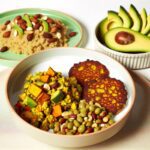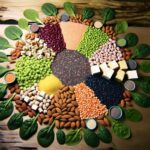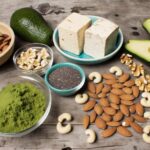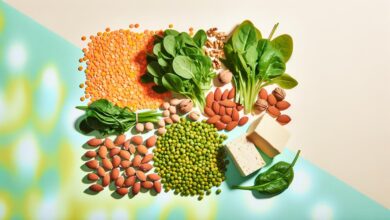You might not be aware, but ancient grains like quinoa and amaranth pack a powerful protein punch, without a trace of gluten or animal products. As you navigate the vibrant mosaic of plant-based proteins, you’ll find that these ancestral seeds offer more than just essential amino acids; they carry centuries of cultural heritage and culinary versatility. Legumes, nuts, and seeds might already be staples in your pantry, yet the secret lies in crafting combinations that transform them into dishes bursting with flavor and nutrition. And while navigating this terrain, you’ll encounter innovative meat alternatives derived from peas and beans that challenge the very notion of what a protein source can be. So, as you ponder your next meal, consider the array of gluten-free vegan proteins that could not only satisfy your palate but also sustain your body and the planet.
Key Takeaways
- Legume-based proteins such as beans, lentils, and chickpeas are versatile, nutritious, and offer a complete protein source when paired with whole grains.
- Nuts and seeds, such as almonds, walnuts, chia seeds, and flax seeds, are excellent vegan protein sources that also provide omega-3 fatty acids and fiber.
- Quinoa and amaranth are gluten-free ancient grains that are complete proteins and can be used in various dishes, including as protein powders for smoothies and baked goods.
- Non-soy meat substitutes, like pea-based and bean-based options, offer essential amino acids and gluten-free protein alternatives, while brands like Beyond Meat provide innovative options that prioritize health and ethical values.
Legume-Based Proteins
Discover the rich flavors and robust nutrition of legume-based proteins—your plant-powered allies like beans, lentils, and chickpeas—that bring both substance and variety to your vegan meals. These culinary staples are more than just versatile; they’re a testament to the bounty of the earth, packed with protein and fiber to meet your dietary needs with gusto.
As you weave the tapestry of your plant-based diet, you’ll find that legume-based proteins are essential threads. They offer a complete protein source when paired with whole grains, ensuring you receive all essential amino acids necessary for optimal health. Imagine the comfort of a warm bowl of lentil soup or the satisfying crunch of a chickpea salad—each bite not only delights the palate but also serves your body’s protein intake needs.
Moreover, embracing legume-based proteins is a gesture of kindness, both to yourself and the planet. They’re budget-friendly, lowering the cost of your grocery bill, and their sustainability supports a more ethical food system. Dive into the world of soy products, where tofu and tempeh transform into delectable dishes, providing adequate protein without compromising your values or flavor. Let these plant proteins nourish your soul as you serve others with meals crafted from the heart.
Nuts and Seed Powerhouses
While legumes like beans and lentils are cornerstones in a plant-based diet, let’s not overlook nuts and seeds, true powerhouses that pack a protein punch along with a crunch that can elevate any dish. These tiny treasures are not just great sources of plant-based protein, but also come with a bounty of essential amino acids, making them integral to your compassionate culinary creations.
Diving into specifics, almonds and walnuts are not only rich in vegan protein sources, they also offer a satisfying texture and flavor that can transform both savory and sweet dishes. When you sprinkle a handful of these nuts into your meal, you’re adding grams of protein per serving that contribute significantly to your daily intake.
Turning to seeds, chia seeds and flax seeds stand out not just for their protein content but for their omega-3 fatty acids and fiber. Their subtle taste means they can slip into smoothies or coat your morning cereal without overpowering your palate. Similarly, pumpkin seeds provide an impressive amino acid profile, and a mere ounce can bestow an extra boost of nutrients and energy.
Quinoa and Amaranth
Step into the world of ancient grains where quinoa and amaranth, both revered for their complete protein profiles, offer a nutritious and flavorful foundation for countless gluten-free vegan meals. Cultivated for thousands of years, these gluten-free grains are not only steeped in cultural heritage but also packed with plant-based proteins that are essential for anyone looking to nourish and sustain a compassionate lifestyle that serves others.
Here’s why incorporating these whole grains into your plant-based diet is a heartfelt choice:
- Quinoa contains all nine essential amino acids, making it a complete protein with approximately 8 grams per cup. It’s a versatile champion in salads, soups, and even as a hearty breakfast porridge.
- Amaranth, similarly, is a tiny grain with mighty nutritional impact, offering about 9 grams of protein per cup and a rich texture that adds soul to every dish.
- Both grains are not just meal enhancers; they’re also available as protein powders, adding a boost of wholesome energy to your smoothies and baked goods.
Non-Soy Meat Substitutes
Building on the protein-rich foundations of quinoa and amaranth, let’s explore the diverse world of non-soy meat substitutes that cater to your gluten-free vegan palate with equally robust flavors. You’re not just looking for alternatives; you’re seeking nourishment that resonates with your cultural insights and a desire to serve others through compassionate food choices.
Venture beyond the realm of foods like tofu, to the innovative landscapes where gluten-free protein is celebrated. Peas and beans, with their essential amino acids, are the unsung heroes in vegan meats. These plant-based sources are transformed into succulent veggie burgers and crumbles that could fool even the most devout carnivores. Seitan, though not gluten-free, is another hearty option for those without Gluten Intolerance, offering a chewy texture reminiscent of meat.
Brands like Beyond Meat have engineered meat alternatives that honor your health and ethical values without compromising on taste or texture. Each bite is a testament to the power of plant-based innovation, delivering all the amino acids necessary for a thriving body.
Embrace these meat alternatives as more than just sustenance; they’re a celebration of flavor, diversity, and a commitment to a healthier, kinder world.
Gluten-Free Grain Varieties
Delve into the world of gluten-free grains where quinoa reigns supreme, offering a complete protein profile that’s as culturally rich as it is nutritious. As someone passionate about serving others, it’s essential to recognize the diverse options available for those with celiac disease or gluten sensitivities. Beyond quinoa, the bounty of gluten-free grain varieties is vast and full of flavor.
Consider these nutritious powerhouses:
- Amaranth: This ancient grain is a cultural treasure, boasting a high protein content and essential minerals like iron and calcium. It’s a sublime choice for enriching your vegan dishes with depth and heartiness.
- Brown Rice: A staple in many cultures, brown rice serves as a versatile base for countless recipes. It’s not only a reliable gluten-free protein source but also a canvas for your culinary creativity.
- Buckwheat: Despite its name, buckwheat is unrelated to wheat and is completely gluten-free. High in protein and fiber, it imparts a robust, earthy flavor to your meals, making it ideal for those seeking nutritious yet indulgent foods.
Remember to always check food labels as you explore these seeds and grains. They’re not just ingredients; they’re the building blocks of compassionate, plant-based eating that respects both tradition and health.
Frequently Asked Questions
What Is a Vegan Source of Protein for Gluten-Free People?
You’re in luck! Plant-based meats, chia protein, and protein-rich grains like quinoa serve as hearty vegan proteins. Don’t forget hemp seeds, nutritional yeast, and sprouted legumes for a nourishing, gluten-free feast.
What Do Vegans Eat to Replace Protein?
You’ll find plant-based meats, protein-rich legumes, and green pea protein fill your plate with flavor while serving nutritional needs. Sprinkle nutritional yeast, savor hemp seeds, and explore spirulina for diverse, compassionate cuisine.
How Do You Get Protein if You Are Gluten and Dairy Free?
“You are what you eat,” so fuel up with protein-rich legumes, nutritional yeast flakes, and hemp seed options. Spirulina adds a protein boost, while quinoa, chia, and buckwheat groats pack a nutritious punch.
Where Can I Get Protein if I Can’t Have Gluten?
You’ll find protein in legume options, quinoa dishes, and protein-rich seeds. Try edamame snacks, nutritional yeast, and hemp hearts. Amaranth benefits your meals, while algae sources and protein powders boost your plant-based diet.







